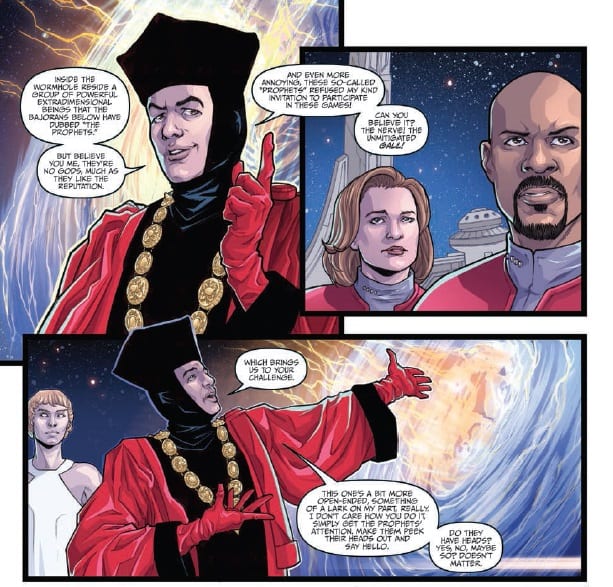Continuing to boldly go where no comic crossover has gone before, Star Trek The Q Conflict reaches Bajoran space and all that Deep Space Nine had to offer. IDW Publishing, and the Tipton’s in particular, are committed to bringing on board as many aspects of the franchise as possible to really give this crossover a universal feel.
Aspects of the original series and the Next Generation have featured heavily so far but now it’s the turn of Captain Sisko’s turf to play host to Q’s outrageous game.

Writing/Story
As per previous issues, Scott and David Tipton have a strong hold on the characters from all of the Star Trek incarnations. Their representations are flawless with each cast member speaking and acting exactly as you would expect them too.
The difference in this issue is that there is finally a threat for the crews to face. As Q’s selfish game continues, he leads the various star ships into Bajoran space and challenges them to ‘bring out the Prophets’. On the Enterprise E, Guinan expresses concern over Q’s true motives, and not without cause. What is Q’s goal and has he over stepped the mark by involving the Wormhole creatures?
This issue unfolds like the previous three issues, with a simple set up and check in with the various mixed crews. However, the Tipton’s have a surprize in store for the cast and the reader as a twist in the tale changes everything. The writers introduce a foreshadowing of this in the opening but this is easily missed, especially as Guinan, true to character, is non-descript in her warnings.
When the moment comes, the twist in the story takes over and the rest of the issue runs out of control, from the reader’s perspective. The Tipton’s have a firm grasp on the narrative and control the pace of the decent perfectly. It’s like they are leading the reader down a Star Trek rabbit hole and for the first time in the series the reader has no idea what to expect.

Art
The artwork also benefits from the change in pace. Silvia Califano and Elisabetta D’Amico have added a layer of dynamism to the panels that help illustrate the spiralling narrative. The characters and the story is becoming bigger and to reflect this the panel boarders are barely able to contain the action. Cast member’s cross over the gutters, images bleed to the edge of the page and when things really begin to heat up, the panels themselves become distorted.
The color work by Alessandra Alexakis is outstanding. It adds depth to the characters and creates the setting that the cast inhabit. The scenery makes the panels in The Q Conflict; grounding the action on the star ships but opening everything up in the space sections. The wormhole has never looked so all encompassing.
Neil Uyetake’s lettering is adequate. It does the job it sets out to do but some of the speech balloon tails over reach and create unnecessary barriers between characters. His depiction of the wormhole aliens’ disembodied voice is finely presented, giving the Prophets a visually distinctive voice.

Conclusion
Previous issues of Star Trek: The Q Conflict have spent too many of the pages on build up and then rushed through the action element of the story. This latest issue has better pacing to the narrative. The dilemma at the centre of the story has time to grow but it also has time to pose an actual threat. The price for this is that the comic features less characters but this is a fair price to pay. Instead of trying to pay lip service to the franchise, this chapter has a story and fits in the relevant characters as they are needed.
The Q Conflict is picking up and it finally has a story worthy of such a momentous crossover of characters. Issue 4 is the best issue so far and it’s not too late to join the party

